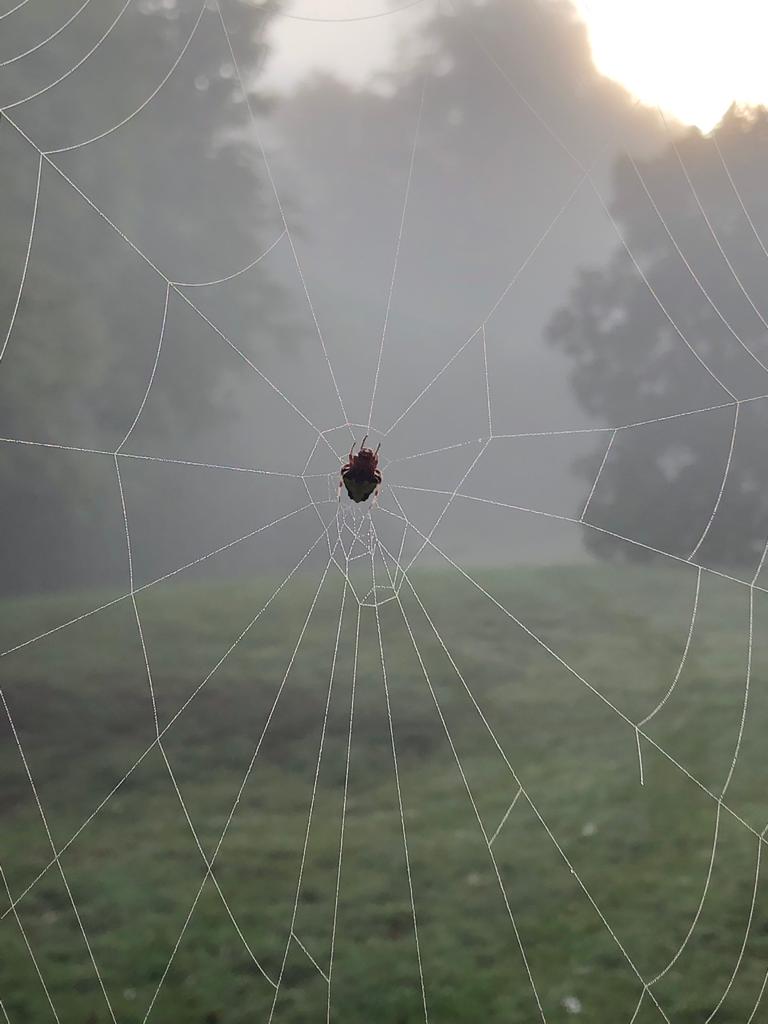Some of us have tried to hold on to our old ideas and the result was nil until we let go absolutely.
Big Book of AA
Great Spirit,
Please help me set aside
everything I think I know
about myself,
……
and especially You;
So, I may have an open mind
and a new experience
of all these things.
Please let me see the truth.
Set Aside Prayer
Still trying to reach the future through the past.
Still trying to carve tomorrow from a tombstone…
Paul Brady, The Island
How many times am I standing in my own way? Old habits die hard. Old thinking patterns have become entrenched. Drawing upon all the mental resources that have amassed over the years, I see no way forward. It seems that I am hopelessly trapped. Long-held fears prevail, and opening myself up to new possibilities and new storylines seems impossible.
There is a neurological explanation for this phenomenon. Neural pathways develop over time in line with our experience and corresponding behaviours. They become etched into our brains, offering themselves as the default, `the only way´. Like the diagonal paths that traverse the lawns of poorly designed public parks, our past behaviour dictates how information flows and is processed in our brains.
Current fears are therefore often merely the echoes of some trepidation experienced much earlier in life. To use the poetic description of the contemporary author David Richo, they are `the wake of a ship which has long since passed.´
New neural pathways develop only as a result of new behaviours. These are born of the conscious appraisal of the status quo, rekindled hope, a genuine intention to change, and the corresponding follow-through. For this process to succeed, it requires consistent and on-going mental fitness training akin to the repetitious working out which we do in the gym to get and remain physically fit.
Prayer is one way of setting intention into motion. It is how we activate hope, turning it into faith. It is about being willing to believe in – yet unseen, – new possibilities of overcoming alienation, lethargy, fatalism, or even cynicism.
For eons, people have been using prayer to outgrow old limiting habits and gain new experience. The intention of the `Set Aside Prayer´ is simple and beautiful. It can be applied to any area of life, for example, relationships – to self and others – , vocation, healing, and growth.
· Relinquishing my defiance.
Someone recently pointed out that `both faith and fear invite me to believe in something I cannot see.´ That gave me a new and refreshing perspective. There is no way that you can really articulate the experience of acting on faith. Words are insufficient. It is something that must be experienced if it is to be fully grasped.
When lingering in defiance, facing something new, feeling just fine on this familiar side of the fence, I can talk myself right out of anything unventured and novel. Here we see fear at work. By refusing life’s invitation, I may be selling myself short. In such circumstances, prayer can help propel me forward.
When I hit difficult patches in life, I am reminded to make a thorough inventory of my `old ideas´, appraising them in blameless discernment, then keeping those that serve my continued healing and growth while ditching the rest. This may sound easier said than done. One challenge is to grasp the nature, depth, and true scope of `old ideas´.
In her 2020 book `Be Water My Friend´, Shannon Lee explores the philosophy and teachings of her father, Bruce Lee. I explore below how some of Lee’s insights help me to let go of my old ideas.
· Letting go of outcomes.
An old idea which has often kept me back is `I’m stuck´. This happens whenever, with a specific outcome in mind, I engage in a pattern of doing the same thing over and over again, expecting a different result.
Bruce Lee encourages us to embrace adaptability. His concept of `be water´ emphasizes the importance of being flexible and adaptable in life. Water can flow and take any form, adjusting to its surroundings. Similarly, we should learn to adapt to changing circumstances, be open to new ideas, and grow with the flow.
This presupposes trust in a power beyond ego, since we need to be willing to be poured into a form which is not of our own design; a form we cannot yet envisage.
Until we reach a healthy degree of mental fitness, the impetus for this willingness generally comes through suffering. It is only when we get sick and tired of being sick and tired that we develop the willingness to ditch old ideas which, upon careful examination, are clearly no longer working.
· From `nowhere´ to `now here´.
A common life-negating pattern (old idea) is to absent ourselves from the present by spending most of our waking hours, mentally, in the past and future. As when we complete a two-hour drive and, getting out of the car, we draw a blank on the details of our journey because our minds had been elsewhere.
Here, Lee suggests the cultivation of mindfulness. He believed in the power of being fully present in the moment. By practicing mindfulness, we can improve our focus, enhance our awareness, and make better decisions. Being mindful allows us to respond to situations with clarity and intention, i.e., consciously, rather than reacting impulsively.
Any exercise that brings us into the present moment; concentrating on our breathing while meditating, on the soles of our feet while walking, or the sensation of the wind on our shoulders while cycling, – any such exercises are beneficial and effective in cultivating our capacity for being present. The more often and consistently we practice, the easier it becomes.
· Stop comparing.
A widespread old idea is to continuously compare. If we closely observe our stream of thoughts, we would be surprised to realise how much time and effort goes into such judgemental comparisons such as: He’s smarter, looks older, less handsome, richer, less conscious, she’s more successful, fatter, faster, slower, more intelligent, I’m more important, responsible, the bigger victim, etc.
It is as if the voice of the Inner Critic, the Judge, is never switched off. This may have its roots in the evolution of our neural capacities pursuant to survival, but this inner voice has, since the Stone Age, clearly become a runaway train.
This mental habit is aggravated and, in turn, spurred on by the competitive nature of the hyper-individualistic culture we have created; the western neoliberal form of `winner-takes-all´ turbo capitalism which, if unchecked, may ultimately destroy humanity, – yes, even its host, – in the pursuit of greed over need; greed, once again, born of fear.
The antidote here is to embrace, celebrate, and cultivate our respective uniqueness. We can learn to express our true selves and not conform to societal expectations. We each have our own unique talents and abilities. Our duty is to identify these, embrace the qualities we find, and manifest them in living lives of purpose. This is true innovation. Only this can lead to personal growth and fulfilment. Engendering this capability in each other, and especially in our children, is one of the highest forms of service.
· Make peace with `no finish line´.
An old idea of mine is the yearning for: `I’m done now.´ The ego wants to have the assurance of a finish line, the promise that we are at some point out of the woods. It would like to know that we can eventually rest up, no longer needing to heal, grow, and adapt. This contradicts the definition of being alive.
The remedy is continual self-improvement. Lee believed in the importance of constant self-improvement and modelled this in his own life, ever eager to push his boundaries. He encourages us to challenge ourselves, set goals, go beyond the comfort zone, and work towards becoming the best version of ourselves. By continuously learning and growing, we can achieve personal excellence and fulfil more and more of our potential.
· Embrace limitations as opportunity.
Most limitations are self-imposed. By recognizing and challenging our own limitations, we can overcome them and achieve greater success. We need to break free from mental barriers and disengage the invisible handbrake.
Mental Fitness helps us identify and intercept our Saboteurs, switch to the life-affirming Sage mode, and engage in benign approaches to moving forward. These include the `Sage Perspective´ (every circumstance bears gifts and opportunities), and the powers of Empathy, Explore, Innovate, Navigate, and Activate.
The Positive Intelligence (PQ) Mental Fitness framework which I find indispensable for my own development, and which is now an integral component of my Transformation Coaching is described in more detail here: https://www.pq-mental-fitness.com/
· Befriend balance in a volatile world.
While water can be both gentle and powerful, we should strive for balance in our lives. This includes balancing professional career and personal life, physical and mental well-being, joy and pain, – all the various aspects of our lives.
This implies relinquishing the emotional roller coaster of my earlier dysfunctional and drama-filled life. Forgiveness for the human shortcomings experienced in these previous chapters and for everybody involved, including my self, is the prerequisite for moving on to more healthy pastures.
· Trust the process.
Finally, life is a continuous journey of self-discovery and growth. Rather than focusing solely on the end goal, we can decide to be grateful and enjoy the process while embracing the challenges along the way. The journey itself holds valuable lessons and opportunities for personal development.
As we read in Ecclesiastes 3: `To every thing there is a season, and a time to every purpose under the heaven: A time to be born, and a time to die; a time to plant, and a time to pluck up that which is planted…´ The idea that we humans can have an all-embracing overview of what we call `life´ is another old idea which needs to go.
Letting go of old ideas can inspire us to live a more mindful, adaptable, and fulfilling life, embracing our uniqueness and continuously working towards self-improvement. The new ideas of today may perhaps become the old ideas of tomorrow. The practice, therefore, requires a daily reset. If undertaken with hope, faith, and genuine intent, new possibilities abound.










